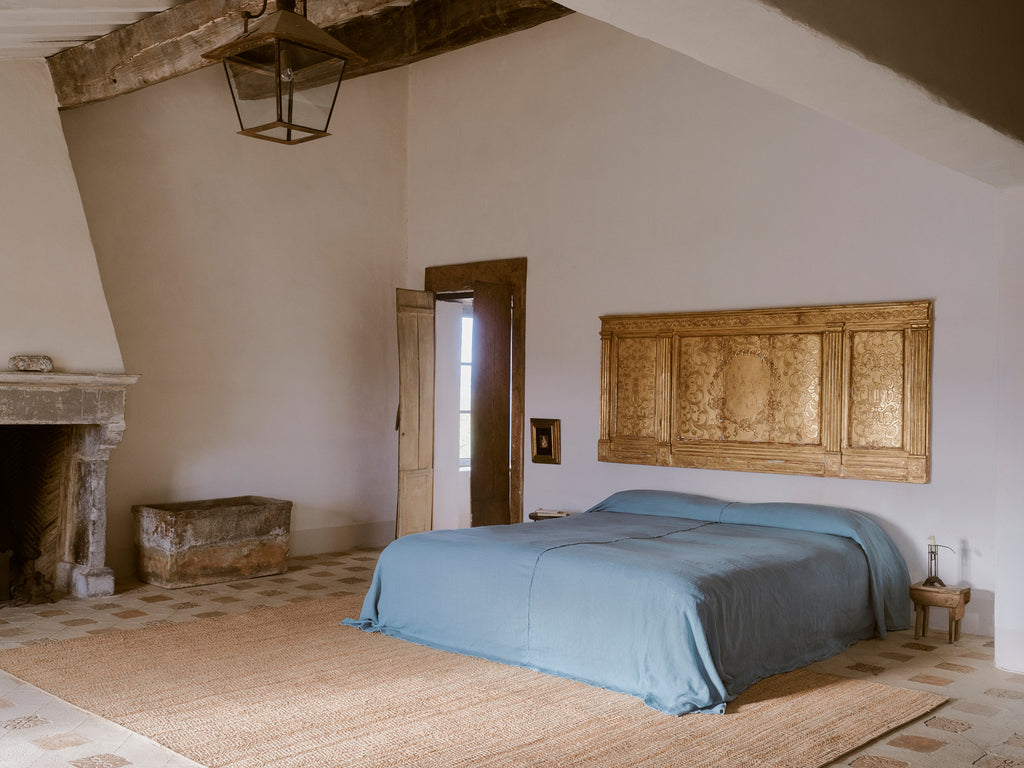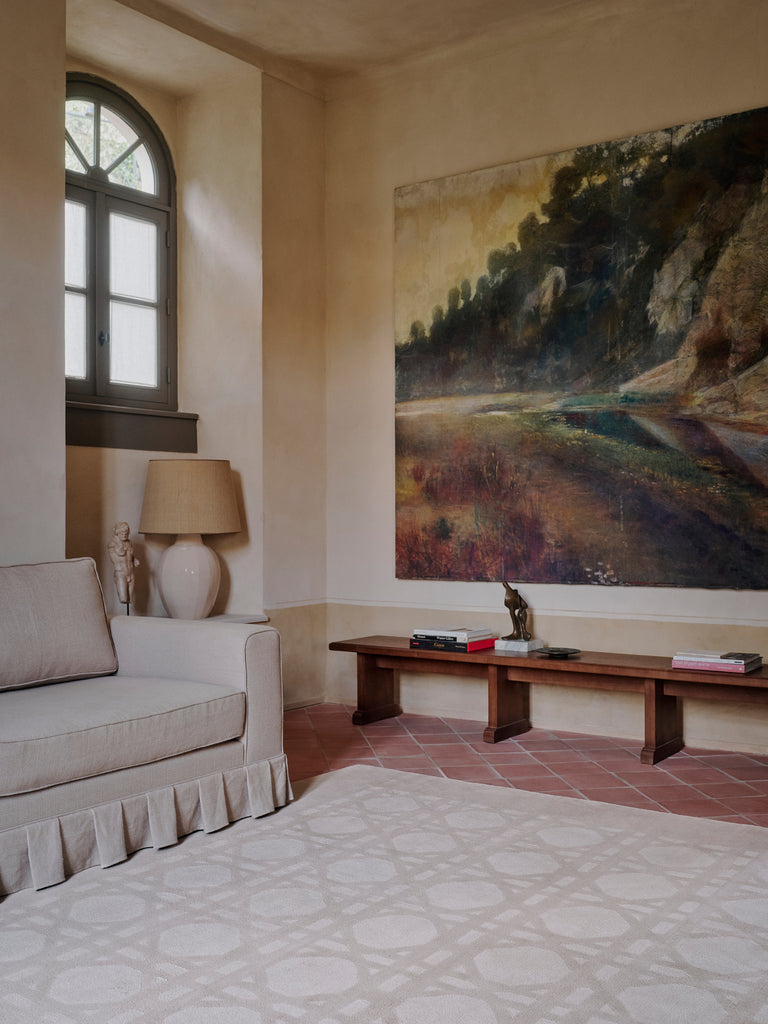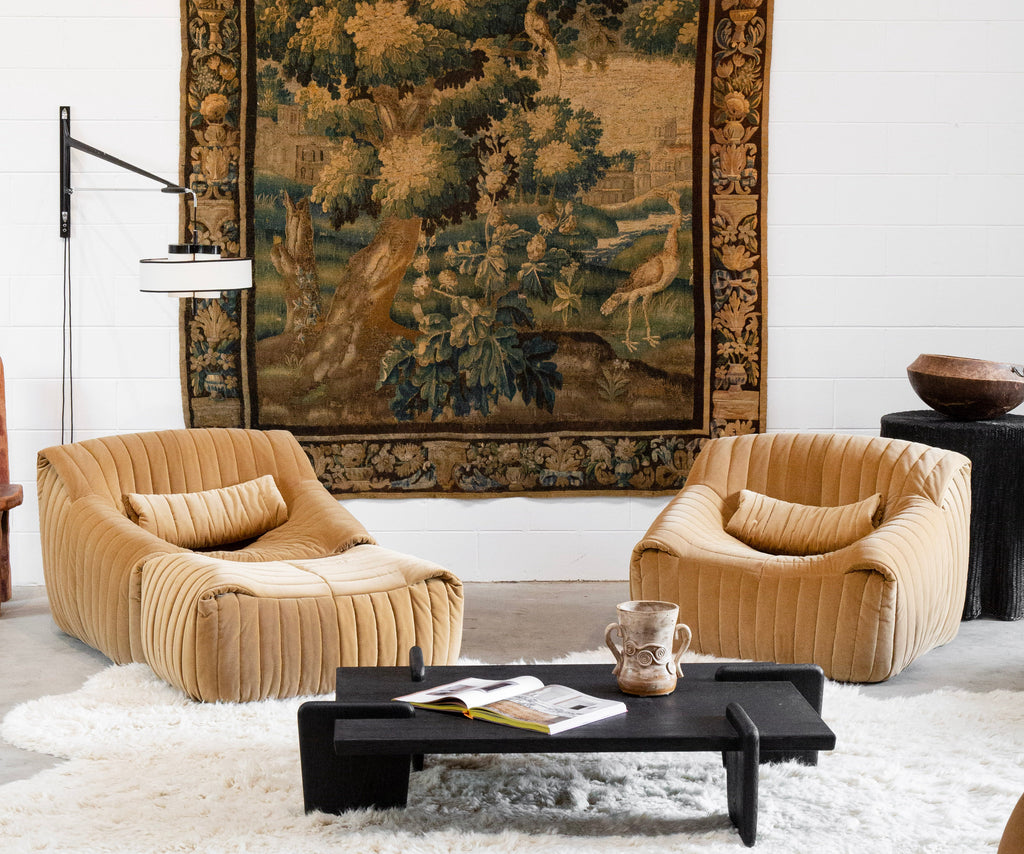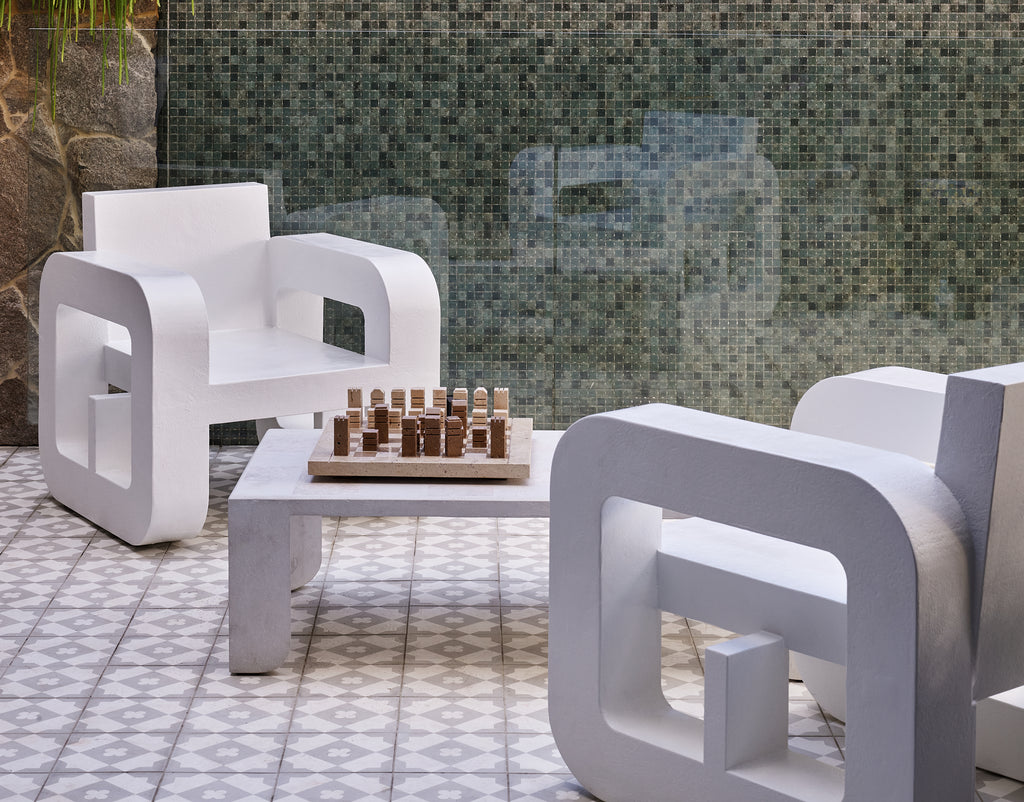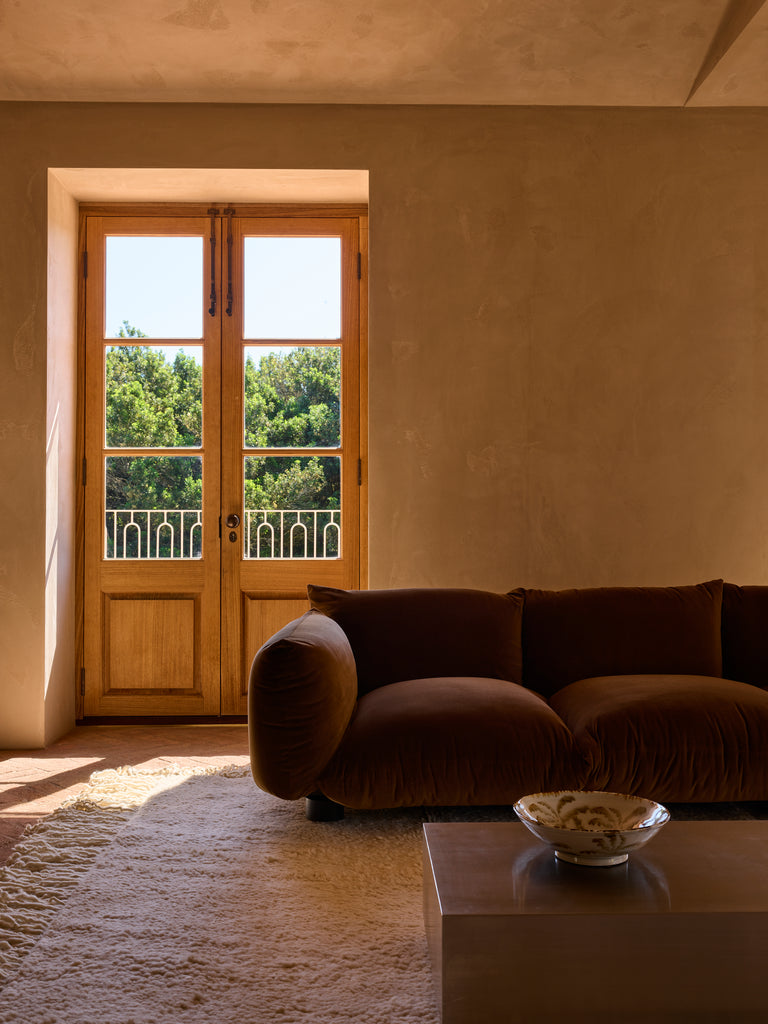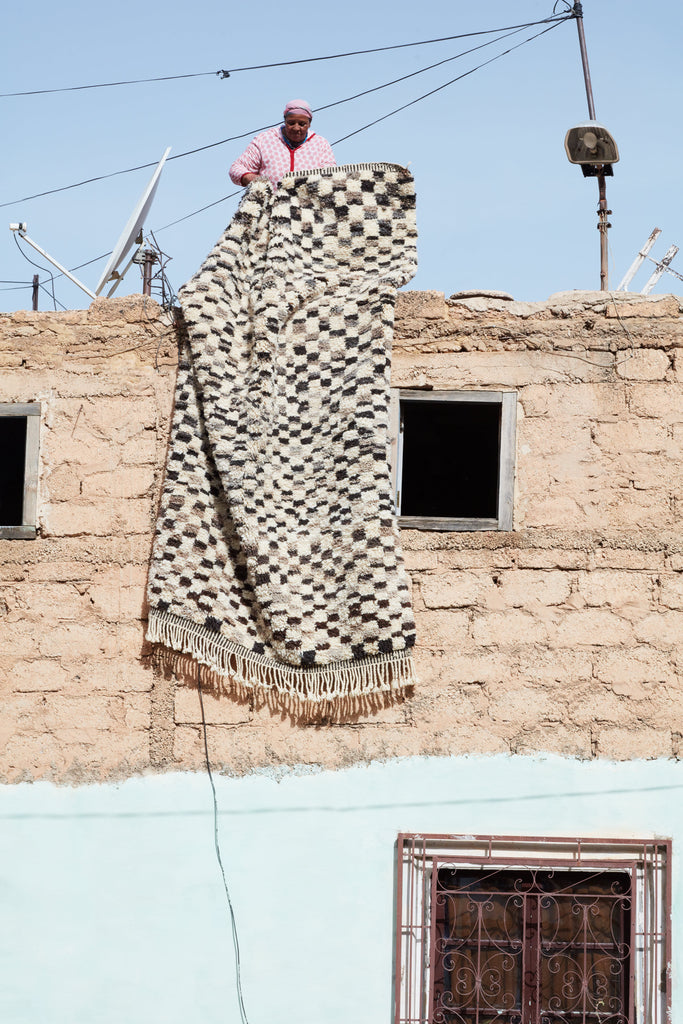Our pieces are crafted with intention — to be lived with, loved, and passed down. Whether vintage or contemporary, each item in our collection has been selected for its enduring quality and timeless design. With a little care, these pieces will age gracefully, developing the character and patina that make them uniquely yours.
Here you’ll find thoughtful guidance on how to care for your Tigmi pieces — from preserving natural materials to ensuring longevity. Because true design should stand the test of time.
Premium Surface Protection
How It Works
To help preserve the beauty of your Tigmi upholstered furnishings and rugs, we’ve partnered with Premium Surface Protection (PSP), an industry leader in eco-friendly textile protection solutions, for residential and commercial use.
PSP’s advanced in-home treatment provides long-lasting protection for your furnishings, including rugs, leather lounges, armchairs, bedheads and cushions. Their certified service helps guard against stains, fading and everyday wear, extending the life of your pieces and offering peace of mind through trusted care.
To learn more, watch this 90-second PSP Video that showcases the transformative value and peace of mind PSP solutions bring to fabric and leather furniture, carpets, and rugs.
This is an in-home service managed entirely between PSP and the client (Tigmi is not involved). To request a quote directly from PSP, visit the following link https://premiumsurfaceprotection.com.au/request-a-quote/
Trusted Partner
PSP client portfolio includes The Calile Hotel, Jardan, King Living, Warwick, AMP Capital, Air New Zealand, University NSW, Designer Rugs, GlobeWest, Hali Rugs, Coco Republic, and many more.
Key Features
Performance:
- Stain and spill protection
- Every day wear protection
- Aqueous liquid and soil repellence
- Mould and mildew repellence
- Strengthens and protects fibres
- Protects the colour of fibres
- Effective on all fibres and leather
- Doesn’t affect colour, feel, or texture
- Reduces flame in the event of a fire
- High performance
- UVA/B resistance
- Anti-microbial
- Low maintenance and easy to clean
Health and Environmental Safety:
- Safe for the environment, people, and pets.
- Zero PFAS or any chemicals of concern
- OEKA-TEX Standard 100 certified
- Woolsafe approve
Technical Points
- Increases liquid repellence to highest possible testing
- Increases Martindale abrasion by up to 10,000 cycles
- Increases Light Fastness by a minimum of 1 level and up to 2 levels
- Increases Pilling resistance by a minimum of 1 level and up to 2 levels
- Reduces the need of cleaning agents and chemicals by up to 75%
Quote & Pricing
This is an in-home service managed entirely between PSP and the client (Tigmi is not involved). To request a quote directly from PSP, visit the following link https://premiumsurfaceprotection.com.au/request-a-quote/
Click on the following link for PSP pricing: PSP Pricing
Rugs
General Care Guidelines
- Use a quality rug underlay – Our underlay provides extra cushioning, prevents slipping, and helps extend the life of your rug by reducing friction with the floor.
- For added protection and durability, we recommend the in-home service of Premium Service Protection (PSP), an eco-friendly textile protection treatment to guard against stains, fading and everyday wear. You can request a quote directly from PSP Quote Request.
- Vacuum regularly – Use a low-suction setting without a rotating brush to prevent fiber damage.
- ProtectMe Upholstery & Rug Protector Spray - Apply an eco-conscious fabric protector creates an invisible barrier that helps repel stains, spills, and everyday dirt. Safe for use on natural fibres, it extends the life of your rug while maintaining its softness and appearance.
- Blot spills immediately – Always use a clean, dry cloth to blot (never rub) spills to prevent them from spreading. If needed, follow up with a mild detergent and water solution specific to your rug's material. For deeper cleaning or stubborn stains, we recommend seeking professional rug cleaning services to ensure the longevity of your Tigmi rug.
- Professional cleaning is recommended – Every 12-18 months, have your rug professionally cleaned to maintain its integrity. If you do employ a professional service, inform them that we do not recommend the use of harsh chemicals, especially on delicate fibers like linen and silk.
- Absorb odors and moisture – To naturally freshen your rug, sprinkle an even layer of baking soda over the surface. Let it sit for a few hours before vacuuming thoroughly. This helps eliminate stale odors left behind by pets, food, or smoke without leaving behind a fragrance.
- Rotate periodically – Turning your rug every 3 months ensures even wear and prevents fading or indentations from furniture.
- Avoid direct sunlight – Prolonged exposure to UV rays can cause colors to fade. If placing your rug in a sunny area, consider using sheer curtains or blinds to minimize exposure.
- Shake or gently beat the rug outdoors – Taking your rug outside and shaking it or lightly beating it helps remove embedded dust and dirt, especially for natural fiber rugs like jute and abaca.
Wool Rugs
Naturally stain-resistant but benefit from regular maintenance.
- Vacuum weekly using a brush-head attachment to prevent dirt from settling into the fibres.
- Use cold water and mild detergent for spot cleaning.
- Blot stains gently; avoid excessive moisture as wool absorbs water.
- Professional wool rug cleaning is recommended for deep stains.
Stain Removal:
- Liquid spills: Blot immediately with a dry, clean cloth.
- Wine, coffee, or tea stains: Blot immediately, apply a mixture of cold water and wool-safe* detergent, blot dry.
- Oil stains: Sprinkle with cornstarch, let sit, then vacuum and blot with mild detergent.
- Mud stains: Allow to dry completely, then vacuum before blotting with mild detergent.
- Food stains: Blot gently with cold water and mild detergent.
- Pet stains: Use a mild enzymatic cleaner for odor removal, blot dry.
*A wool-safe detergent is a gentle, pH-neutral cleaning product specifically formulated to clean wool fibres without damaging them. These detergents avoid harsh chemicals, enzymes, and bleaches that can strip natural oils or cause felting, shrinkage, or color fading.
Wool Long Pile Rugs
Cappelen Dimyr Long Pile Rugs
Long pile wool rugs offer natural warmth, softness, and a plush, inviting texture. Their deeper fibre structure requires gentle, regular maintenance to keep the pile lifted. However, all long pile products tends to shed initially and we therefor recommend you to vacuum daily for an initial period. It is normal for the woolen products to loose individual fibers, and the excess fibers does not affect the quality of the product. We recommend to vacuum without a rotary brush spout on our long piled product, since there is a risk of damaging the yarn. Also make sure not to use a heavy beater bar or have the vacuum on the setting closest to the ground. Shedding tends to decrease within a couple of months.
- Shake or gently beat the rug outdoors to release dust and revive the pile.
- Vacuum with care using low suction only. Use the upholstery attachment and avoid rotating brushes which can pull or break long wool fibres.
- Use a quality rug underlay to reduce friction, add cushioning, and help the pile retain height over time.
- Keep the rug out of direct sunlight and rotate to prevent uneven fading.
- If you choose to use a professional cleaning service, ensure they specialise in wool and avoid the use of harsh chemicals. Wool responds best to cool water, gentle handling, and wool safe detergents.
- Spot clean using cool water and a wool safe detergent. Blot only. Avoid rubbing to prevent felting or matting.
Stain Removal:
- Liquid Spills: Blot immediately with a clean cloth. Lift the pile gently to reach trapped liquid and continue blotting until dry.
- Oil Stains: Sprinkle lightly with cornstarch or baking soda to absorb oils. Leave for several hours, then vacuum. Blot with cool water and wool safe detergent if residue remains.
- Wine, Coffee, Tea: Blot quickly to remove excess liquid. Clean with cool water mixed with a small amount of wool safe detergent. Work from the outside of the stain inward.
- Mud: Allow mud to dry completely. Vacuum gently to lift dry soil. Spot clean with cool water and wool safe detergent if needed.
- Ink: Blot only. Do not rub. Ink is difficult to remove so professional cleaning is recommended.
- Food Stains: Remove solids gently with a spoon. Blot with cool water and wool safe detergent. Avoid scrubbing or applying friction.
- Pet Stains: Blot thoroughly to remove moisture. Clean with cool water and wool safe detergent. Avoid enzyme cleaners unless specifically marked safe for wool.
Wool & Cashmere Blend Rugs
Soft, luxurious texture with the same qualities and durability as wool.
- Vacuum lightly and brush with a soft-bristle brush to maintain texture.
- Spot clean using cold water and mild detergent; avoid rubbing fibres.
Stain Removal:
- Liquid spills: Blot immediately with a dry, clean cloth.
- Wine, coffee, or tea stains: Blot immediately, apply a mixture of cold water and wool-safe detergent, blot dry.
- Oil stains: Sprinkle with baking soda, let sit, then vacuum and blot with mild detergent.
- Mud stains: Allow to dry completely, then vacuum before blotting with mild detergent.
- Food stains: Blot gently with cold water and mild detergent.
- Pet stains: Use a mild enzymatic cleaner for odor removal, blot dry.
Wool & Linen Blend Rugs
More absorbent than pure wool; treat spills quickly.
- Vacuum regularly with gentle suction to prevent dust buildup.
- Spot clean with a mild, pH-neutral detergent.
- Avoid excessive moisture, as linen fibers can weaken when wet.
Stain Removal:
- Liquid spills: Blot immediately with a dry cloth.
- Wine, coffee, or tea stains: Dab with a mild detergent solution, blot dry.
- Oil stains: Sprinkle with cornstarch, let sit, then vacuum and blot with mild detergent.
- Mud stains: Allow to dry, then vacuum before spot cleaning.
- Food stains: Gently blot with a diluted mild detergent solution.
- Pet stains: Use an enzymatic cleaner, blot dry.
Wool & Silk Blend Rugs
- Silk fibres are delicate—vacuum with extra care using a low-suction setting. Avoid using brush attachments as they may stretch and damage the silk fibres.
- Professional cleaning is highly recommended over DIY spot treatments.
- Keep dry—excess moisture can damage silk fibres.
Stain Removal:
- Liquid spills: Blot immediately with a dry, absorbent cloth.
- Wine, coffee, or tea stains: Blot with a clean cloth and a mild detergent solution.
- Oil stains: Apply a small amount of baking soda, let sit, then vacuum gently.
- Mud stains: Let dry, brush off excess dirt, then blot clean.
- Food stains: Dab with a diluted mild detergent solution, avoid excess moisture.
- Pet stains: Blot with an enzymatic cleaner, then dry immediately.
Jute Rugs
Known for its soft, natural feel underfoot, jute is best suited to low- to moderate-traffic areas.
- Avoid moisture—jute absorbs water easily and can become brittle when wet.
- Vacuum frequently to prevent dirt accumulation.
- Blot stains quickly with a dry cloth; avoid scrubbing.
Stain Removal:
- Liquid spills: Blot immediately; use a dry-cleaning powder if needed.
- Wine, coffee, or tea stains: Blot with a clean cloth and apply a mild detergent solution.
- Oil stains: Sprinkle with baking soda, let sit, then vacuum.
- Mud stains: Let dry completely, then brush off dirt and spot clean if necessary.
- Food stains: Blot with cold water and mild detergent.
- Pet stains: Use an enzymatic cleaner to break down stains and odours, then blot dry.
Jute & Leather Rugs
Requires gentle handling to preserve both materials.
- Vacuum with a brush attachment to prevent pulling.
- Keep away from excessive moisture to prevent warping.
- Condition leather sections occasionally with a leather-safe conditioner.
Avoiding and Treating Mould on Leather:
- To prevent mould, keep leather areas dry and avoid excessive exposure to humidity. If possible, place the rug in a well-ventilated area.
- If mould is present, gently blot the affected area with a cloth dampened with a mixture of water and white vinegar (1:1 ratio). Be cautious not to over-wet the leather.
- Allow the leather to air dry naturally, away from direct sunlight or heat sources, as these can cause the leather to crack.
- After cleaning, apply a leather conditioner to help restore moisture and prevent the leather from drying out.
Stain Removal:
- Liquid spills: Blot immediately with a dry cloth.
- Wine, coffee, or tea stains: Blot with a clean cloth and apply a mild detergent solution.
- Oil stains: Use a leather-safe cleaner for leather areas and blot fabric sections with mild detergent.
- Mud stains: Let dry, then vacuum before spot cleaning.
- Food stains: Gently blot with a diluted mild detergent solution.
- Pet stains: Use an enzymatic cleaner to break down stains and odors, then blot dry.
Abaca Rugs
Strong, natural fibre with excellent durability.
- Keep away from prolonged exposure to moisture.
- Shake out regularly and vacuum with a brush attachment.
- Blot spills immediately; avoid using excessive water.
Stain Removal:
- Liquid spills: Blot immediately with a dry, clean cloth.
- Wine, coffee, or tea stains: Blot with a clean cloth and apply a mild detergent solution.
- Oil stains: Sprinkle with cornstarch, let sit, then vacuum and blot with mild detergent.
- Mud stains: Allow to dry completely, then brush off excess dirt before spot cleaning.
- Food stains: Blot gently with cold water and mild detergent.
- Pet stains: Use a mild enzymatic cleaner for odor removal, blot dry.
PET Rugs
Made from recycled materials, highly durable, and stain-resistant.
- Suitable for both indoor and outdoor use.
- Vacuum regularly to prevent dust buildup.
- Spot clean with mild soap and water; rinse thoroughly and air dry.
- Can be gently hosed down for deeper cleaning.
Stain Removal:
- Liquid spills: Blot immediately with a dry, clean cloth.
- Wine, coffee, or tea stains: Blot with a clean cloth and apply a mild detergent solution.
- Oil stains: Use a small amount of dish soap and warm water, blot dry.
- Mud stains: Allow to dry, then brush off excess dirt before washing.
- Food stains: Blot immediately and clean with mild detergent.
- Pet stains: Use a mild enzymatic cleaner for odour removal, blot dry.
Oushak Rugs
Handwoven with wool pile and cotton foundation, Oushak rugs are vintage pieces that require delicate care. Their age and natural fibers make them more sensitive to moisture and cleaning chemicals.
- Vacuum gently with a low-suction setting, avoiding the fringe which is part of the cotton foundation.
- Rotate occasionally to protect areas from uneven fading or wear.
- Avoid placing in direct sunlight to preserve natural dyes.
Stain Removal:
- Liquid spills: Blot immediately with a dry, absorbent cloth, never rub. Follow with cold water and blot dry.
- Oil stains: Apply cornstarch to absorb oil, let sit, vacuum, then blot with diluted mild detergent.
- Wine, coffee, or tea stains: Blot straight away with cold water and wool-safe detergent.
- Mud stains: Allow to dry completely, gently brush off soil, then vacuum and blot with mild detergent.
- Ink stains: Use a cloth lightly dampened with rubbing alcohol; blot carefully.
- Food stains: Remove solids gently with a spoon, blot with mild detergent and water.
- Pet stains: Blot immediately, then use an enzymatic cleaner sparingly, ensuring minimal moisture.
Furniture, Lighting & Homewares
General Care Guidelines
At Tigmi, we believe well-crafted furniture is made to last, and with the right care, it will only become more beautiful with time. Here's how to look after your pieces to preserve their character and functionality for years to come.
Many of our pieces are made from natural or hand-finished materials. Variations in tone, texture, and patina are part of their inherent beauty, not flaws, but signs of craftsmanship and authenticity.
Daily & Weekly Care
- Dust regularly using a soft, dry cloth to prevent surface build-up.
- Vacuum upholstery weekly with a brush attachment to remove dirt and debris.
- Wipe spills immediately with a clean, dry cloth — avoid rubbing or using harsh chemicals.
Protective Measures
- Use coasters, placemats, and trivets to protect against heat, moisture, and scratches.
- Avoid direct sunlight where possible, as it can cause fading or drying across timbers, textiles, and leathers.
- Lift rather than drag furniture to avoid damaging floors or frames.
Temperature & Humidity
- Keep away from heat sources such as radiators and air conditioning units to prevent warping, cracking, or shrinkage in wood and upholstery.
- Maintain stable humidity levels, especially with natural materials like timber, rattan, or leather, which can expand or contract with climate shifts.
Cleaning Products
- Use mild, pH-neutral cleaners when needed, and always spot-test in an inconspicuous area first.
- Avoid ammonia, bleach, and silicone-based polishes unless specified as safe for the material.
- For stubborn stains or specialty materials, professional cleaning is recommended.
Zeoform™ Micro Pulp - Natura Lighting
- For Dry Environments: The Zeoform lamp shades feature a water-resistant coating, but keeping them in dry environments is essential. Avoid placing them in areas with high humidity or moisture.
- Dust Removal: Regularly dust the lampshades using a clean, dry microfibre cloth or brush. Gently wipe away dust and debris to maintain a pristine appearance.
- Avoid Oils: When cleaning your lampshades, use a microfibre cloth without oils or cleaning solutions. Oils can affect the water-resistant coating and compromise the material's integrity.
- Gentle Cleaning: Remove dust using a soft brush. Lightly dampen a microfiber cloth with water and a mild soap solution, never spray cleaners directly onto the product. Gently wipe the surface to lift any marks or stains, taking care not to apply pressure, as this may damage the finish. Ensure the lampshades are completely dry afterwards. For stubborn marks, gently rub the area with a clean white eraser, then brush away any residue with a soft cloth or brush.
- Avoid Sunlight Exposure: While your lampshades are designed to enhance the ambience, they are
made from natural materials, and prolonged exposure to direct sunlight may cause fading, discolouration, or warping over time. Consider rotating the shades periodically to ensure even ageing. - Storage: If you need to store the lampshades temporarily, choose a cool, dry area away from direct sunlight. Protect them from potential impacts or pressure that could deform their shape. It is best practice to fill the inside void of the product to ensure it retains shape and symmetry.
Silk Lampshades - Oi Soi Oi
- To preserve the beauty of your silk lampshade, keep it out of direct sunlight to prevent fading.
- Dust regularly with a soft feather duster or microfiber cloth, using gentle downward strokes. For a deeper clean, use a soft brush to lift dust from seams or lightly vacuum on the lowest setting while keeping a small distance from the shade.
- If needed, spot clean only. Use a tiny amount of mild soap diluted in cool water and dab lightly with a clean white cloth, then blot dry. Avoid any harsh cleaners as they can damage the silk.
- Handle the shade with clean hands and avoid exposing it to moisture or humidity.
Plaster - Helene Konig Pieces
Each piece is handcrafted with care using delicate materials and artisanal techniques. To preserve their integrity and beauty over time, we recommend the following care guidelines:
- Sculptural Artworks: Due to their three-dimensional nature, artworks may accumulate dust over time.
- Use a soft, dry duster or a gentle microfibre cloth to lightly remove dust.
- For more thorough cleaning, a slightly damp, non-abrasive cloth or dust wipe can be used with care. Avoid soaking or applying pressure.
- Do not use chemical cleaners or sprays, as they may damage the surface or texture.
Sculptural Tables & Stools: Although sealed with a protective varnish, these pieces are primarily artistic and should be treated with care.
- Avoid contact with liquids or materials that could stain, as the plaster surface may remain porous in some areas.
- Use coasters or a soft cloth under decorative objects such as lamps or ceramics to prevent scratches or marks.
- Gently dust with a microfiber cloth or duster; a lightly damp cloth may be used if necessary.
- Avoid placing sharp, abrasive, or heavy objects directly on the surface to prevent chipping or indentation.
Metal
Aluminium: Lightweight and corrosion-resistant, aluminium is ideal for indoor and outdoor use.
- Cleaning: Wipe with a soft cloth and mild soapy water. Avoid abrasive cleaners or pads that can scratch the surface.
- Oxidation: Aluminium naturally forms a protective oxide layer. If left outdoors, this may dull the finish. Occasional cleaning and a light polish with a non-abrasive metal polish can maintain its sheen.
- Avoid: Harsh chemicals, salt buildup near coastal areas (rinse regularly if used outdoors).
Stainless Steel: Durable and modern, stainless steel resists rust but benefits from routine care.
- Cleaning: Use a soft cloth with warm water and a small amount of dish soap. Rinse and dry thoroughly.
- Polishing: Use a stainless steel polish or cleaner to restore shine and remove fingerprints or smudges. Always rub in the direction of the grain. We recommend using Wurth Stainless Steel Care Spray.
- Avoid: Chlorine-based cleaners and prolonged contact with moisture to prevent staining.
Brass: Brass will naturally patina over time, developing a warm character that is part of its charm.
- Cleaning: Dust regularly. Use a damp cloth with mild soap if needed, then dry thoroughly.
- Polishing (optional): If a polished look is preferred, use a brass polish sparingly. Test in a hidden area first.
- Note: Many of our brass pieces are unlacquered and will age gracefully. The patina is not considered a flaw, but a part of the material’s beauty.
Bronze: Bronze is a living finish that develops a rich patina with time and touch.
- Cleaning: Wipe with a dry or slightly damp microfiber cloth. Do not scrub or polish aggressively.
- Preserving the patina: Avoid commercial cleaners or polishes unless the intention is to restore shine, which may remove the aged finish.
- Note: Handle with clean hands to avoid unwanted marks. Over time, these contribute to the character of the piece.
Copper: Like brass and bronze, copper will develop a natural patina that adds depth and warmth.
- Cleaning: Use a soft cloth with mild soapy water. Avoid acidic or abrasive cleaners.
- Patina management: To maintain a polished look, apply a copper-specific cleaner. For aged appeal, allow the patina to develop naturally.
- Note: Fingerprints and oxidation are normal and part of the evolving character of copper.
Powdercoated Steel (Soleil Collection): Powder coating creates a durable and protective finish with minimal maintenance.
- Cleaning: Gently wipe with a damp cloth and mild soap. Rinse and dry with a soft cloth.
- Protection: For outdoor use, clean regularly to prevent buildup of pollutants or salt spray.
- Avoid: Harsh solvents, abrasive cleaners, and sharp objects that can chip the coating.
Timber
Solid Timber: Solid timbers bring warmth, character, and longevity to furniture — each piece is uniquely expressive.
- Cleaning: Wipe with a slightly damp cloth, followed by a dry one. Use gentle soap only when necessary.
- Care: Condition occasionally with a timber-specific oil or wax (unless otherwise specified) to prevent drying or splitting.
- Environment: Avoid direct sunlight, air vents, or extreme humidity changes to minimise warping or cracking
- Note: Natural variations, movement, and minor hairline cracks are to be expected and celebrated in solid wood pieces.
Timber Veneer: Timber veneer offers the natural beauty of real wood in a refined, lightweight finish. With the right care, it will maintain its warmth and character for many years.
- Cleaning: Dust regularly with a soft, dry cloth. For occasional deeper cleaning, use a damp (not wet) cloth with a mild, pH-neutral soap. Always wipe in the direction of the grain, and dry immediately with a clean cloth to prevent moisture from seeping into the surface.
- Care: Use coasters, placemats, and felt pads to protect against scratches, heat, and moisture. Avoid placing hot or wet items directly on the surface.
- Avoid: Do not use abrasive pads, harsh chemical cleaners, or silicone-based polishes, as these can damage the finish or cause buildup over time.
- Sunlight & Humidity: Prolonged exposure to direct sunlight can cause fading or uneven colouration. Keep away from heat sources or areas with extreme humidity fluctuations to prevent warping or lifting at the edges.
- Note: Timber veneer is a natural material, slight variations in tone and grain are to be expected and celebrated as part of its organic character.
Vintage Timber: Aged timbers carry a rich story, full of texture, imperfections, and history.
- Cleaning: Dust regularly with a dry cloth. Lightly dampened cloths can be used for occasional cleaning, but avoid over-wetting.
- Care: To preserve the integrity of vintage wood, avoid using oils, waxes, or commercial polishes unless specifically recommended. If restoration is required, we suggest seeking professional guidance or feel free to reach out and we’ll connect you with our Restoration Manager.
- Character: Marks, wear, and variation are intentional and part of the material’s lived-in appeal. These should not be considered flaws.
- Avoid: Abrasives, strong cleaning agents, or trying to overly “correct” imperfections.
Lacquered Wood: Lacquer provides a smooth, protective finish that enhances the wood beneath while sealing the surface.
- Cleaning: Wipe with a soft, slightly damp cloth and dry immediately. Avoid soaking or scrubbing.
- Maintenance: Keep lacquered surfaces free from dust and fingerprints. Use a microfiber cloth regularly to maintain sheen.
- Protection: Avoid placing hot and wet items directly on the surface, and use felt pads to prevent scratching.
- Avoid: Alcohol-based cleaners, acetone, or anything abrasive, these may dull or damage the finish.
Wicker / Rattan
Natural wicker and rattan are lightweight yet strong, and they age beautifully with care.
- Cleaning: Dust regularly with a soft brush or vacuum with a brush attachment. For deeper cleaning, wipe gently with a damp cloth and dry immediately.
- Conditioning: To nourish the fibres and prevent drying out, apply a small amount of orange peel oil with a soft cloth. This helps maintain flexibility and adds a natural sheen.
- Indoor Use: Keep out of direct sunlight to prevent fading and brittleness. Maintain moderate humidity levels to avoid cracking.
- Outdoor Use (if applicable): Store under cover or indoors when not in use. Prolonged exposure to weather can degrade the material over time.
- Avoid: Excessive moisture, standing water, or heavy weight placed on woven surfaces.
Ceramic
Crafted from natural materials and often hand-glazed, ceramics are durable yet delicate.
- Cleaning: Wipe with a soft, damp cloth. For deeper cleaning, use mild soap and water, then dry thoroughly.
- Handling: Avoid sharp impacts and dragging ceramic objects across hard surfaces to prevent chipping.
- Glazed Finishes: Can be gently cleaned with a non-abrasive sponge. Avoid acidic or harsh chemical cleaners, especially on matte glazes.
- Outdoor Use (if applicable): Some ceramics are suitable for outdoor use — if unsure, bring indoors during extreme weather.
- Tablewear: Unless the maker clearly states it's dishwasher safe, hand washing is recommended for handmade glazed ceramics — especially for pieces that are valuable, sentimental, or irregular in shape.
Glass / Mirror
Timeless and reflective, glass and mirrors enhance light and space but require careful handling.
- Cleaning: Use a soft lint-free cloth and a glass-specific cleaner or a mix of water and vinegar. Spray cleaner onto the cloth rather than directly onto the surface.
- Edges & Backing: Be gentle around the edges and avoid moisture around backing or foil layers to prevent peeling or corrosion.
- Avoid: Abrasive cloths or cleaners, and dragging objects across glass tops.
- Tip: For mirrors, avoid ammonia-based products near the edges — they can cause black spotting over time.
Fibreglass
Lightweight and incredibly strong, fibreglass is used for its sculptural flexibility and resilience.
- Cleaning: Wipe with a soft cloth and warm soapy water. Rinse and dry with a clean cloth.
- Maintenance: Use a gentle plastic or fibreglass polish to restore shine if the surface becomes dull.
- Avoid: Abrasive cleaners or solvents, which may scratch or degrade the finish.
- Tip: Avoid prolonged exposure to direct UV light where possible to prevent yellowing over time.
Perspex / Plastic
Durable and lightweight, Perspex and high-quality plastics offer a clean, modern finish - but require gentle care to avoid surface damage.
- Cleaning: Use a soft, damp microfibre cloth with mild soapy water. Rinse and dry with a clean cloth.
- Polishing: For Perspex/acrylic, a plastic-safe polish can help remove fine scratches and restore clarity.
- Avoid: Abrasive sponges, glass cleaners, or ammonia-based products (like Windex), which can cause clouding or micro-cracks.
- Tip: Dust with a microfibre cloth only - dry dusting with rough cloths can cause fine surface scratches.
Concrete
Raw and textural, concrete offers a sculptural and durable finish. Each piece will display unique surface variation, pores, and natural patina over time.
- Cleaning: Wipe with a damp cloth and mild soap. Avoid excessive water and dry immediately.
- Sealed Surfaces: Many concrete pieces are sealed to resist stains, but spills should still be cleaned promptly, especially liquids like wine, coffee, or oils.
- Care: To protect the surface, use coasters or placemats and felt pads under objects to avoid scratches. Re-sealing may be required periodically depending on use.
- Avoid: Acidic cleaners, vinegar, lemon juice, harsh scrubbing pads, or anything abrasive that could damage the sealant or surface.
- Note: Hairline cracks and subtle colour shifts are part of concrete’s natural aging and character, not considered flaws.
Fabric & Upholstery
General Care Guidelines
Upholstered furniture requires thoughtful, ongoing care to maintain appearance and longevity. For added protection and durability, we recommend the in-home service of Premium Service Protection (PSP), an eco-friendly textile protection treatment to guard against stains, fading and everyday wear. You can request a quote directly from PSP Quote Request.
- Regular Care: Vacuum gently using an upholstery attachment to remove dust and debris. Rotate and flip cushions regularly to maintain shape and even wear.
- Spot Cleaning: Blot spills immediately with a clean, dry cloth, do not rub. If needed, use a mild, fabric-safe upholstery cleaner. Always test in an inconspicuous area first.
- Sunlight & Heat: Avoid prolonged exposure to direct sunlight, which may cause fading, and keep furniture away from heat sources to prevent drying or warping.
- Professional Cleaning: For deep cleaning, use a professional upholstery service familiar with the specific fabric.
NARA Sofa
For added protection and durability, we recommend the in-home service of Premium Service Protection (PSP), an eco-friendly textile protection treatment to guard against stains, fading and everyday wear. You can request a quote directly from PSP Quote Request.
Cotton Velvet: Cotton velvet is rich, tactile, and elegant, with a natural softness and distinctive sheen. As a natural fibre, it requires mindful care to preserve its beauty and texture over time.
- Clean & Refresh: Vacuum gently using a soft brush attachment to remove dust and lift the pile. Do this weekly to prevent dirt settling into the nap.
- Brushing the Pile: Use a velvet upholstery brush or a soft clothes brush to gently lift and restore the nap. Brush in the direction of the pile to maintain its natural movement and sheen.
- Dry Stains: Scrape away any debris from the surface with a dull knife or spoon. Using a damp cloth and a solution of one part dishwashing detergent to ten parts water, gently blot the stain, (never rub) working your way in a circle from the outside of the stain to the middle. Repeat the process as necessary until the stain is removed.
- Wet Stains: Blot immediately with slightly damp cloth. After removing a stain, pat dry with a clean lint-free cloth; as the fabric dries, brush gently in the direction of the pile. If needed, use a damp cloth with a mild pH-neutral soap, but avoid over-wetting. Always test in an inconspicuous area first. Allow to air dry, then brush the nap to revive the texture.
- Avoid: DO NOT use any cleaning product that contains bleach.
- Creases & Pressure Marks: For slight bruises or crush marks, steam the velvet (keeping at a distance to avoid water drops forming on the pile’s surface) and gently brush with a fabric brush in the direction of the pile.
- Sunlight & Fading: Cotton velvet is prone to fading over time with direct UV exposure. Position away from direct sunlight or use sheer curtains or blinds to protect the fabric.
- Professional Cleaning: For deep cleans, we recommend using a professional upholstery cleaner experienced with velvet.
- General Tip: Cotton velvet will age and soften over time, developing subtle variations in the pile, this is part of its character, not a flaw.
Wool Blend: Upholstered in an Italian fabric blend of wool, cotton, and jute, chosen for its warmth, softness, and durability. Wool blends are naturally breathable and to a degree stain-resistant, but they do require gentle and mindful care.
- Vacuum regularly using a brush attachment to lift dust and maintain the fabric’s texture.
Spot clean with cool water and a wool-safe detergent, blotting gently, never rub, as this can damage the fibers. - Avoid harsh chemical cleaners or abrasive cloths.
- Wool fibers can felt or shrink when exposed to friction or heat, avoid scrubbing, hot water, or steam cleaning.
- Use Tigmi’s Advanced Premium Fabric Protector to add a barrier against spills and everyday use.
- Pilling may naturally occur over time with use. This can be carefully removed with a fabric shaver to restore a smooth finish.
Wool Blend
Wool blends offer warmth, softness, and durability. They are naturally stain-resistant to a degree but require gentle care.
- Cleaning: Vacuum regularly using a brush attachment. Spot clean with cool water and a wool-safe detergent, blotting gently.
- Care: Wool can felt or shrink with friction or heat, avoid scrubbing or steam cleaning.
- Note: Pilling may occur with use and can be removed carefully with a fabric shaver.
Cotton Velvet
Cotton velvet is rich, tactile, and elegant, with a natural softness and distinctive sheen. As a natural fibre, it requires mindful care to preserve its beauty and texture over time.
- Clean & Refresh: Vacuum gently using a soft brush attachment to remove dust and lift the pile. Do this weekly to prevent dirt settling into the nap.
- Brushing the Pile: Use a velvet upholstery brush or a soft clothes brush to gently lift and restore the nap. Brush in the direction of the pile to maintain its natural movement and sheen.
- Dry Stains: Scrape away any debris from the surface with a dull knife or spoon. Using a damp cloth and a solution of one part dishwashing detergent to ten parts water, gently blot the stain, (never rub) working your way in a circle from the outside of the stain to the middle. Repeat the process as necessary until the stain is removed.
- Wet Stains: Blot immediately with slightly damp cloth. After removing a stain, pat dry with a clean lint-free cloth; as the fabric dries, brush gently in the direction of the pile. If needed, use a damp cloth with a mild pH-neutral soap, but avoid over-wetting. Always test in an inconspicuous area first. Allow to air dry, then brush the nap to revive the texture.
- Avoid: DO NOT use any cleaning product that contains bleach.
- Creases & Pressure Marks: For slight bruises or crush marks, steam the velvet (keeping at a distance to avoid water drops forming on the pile’s surface) and gently brush with a fabric brush in the direction of the pile.
- Sunlight & Fading: Cotton velvet is prone to fading over time with direct UV exposure. Position away from direct sunlight or use sheer curtains or blinds to protect the fabric.
- Professional Cleaning: For deep cleans, we recommend using a professional upholstery cleaner experienced with velvet.
- General Tip: Cotton velvet will age and soften over time, developing subtle variations in the pile, this is part of its character, not a flaw.
Cotton Blend
Cotton blends are breathable, soft to the touch, and offer a relaxed, lived-in feel. Blending cotton with other fibres enhances durability while retaining its natural comfort.
- Cleaning: Vacuum regularly with a soft brush attachment to lift dust and prevent build-up.
- Spills: Blot immediately with a clean cloth. Use mild soap and lukewarm water to spot clean, dabbing gently from the outer edge of the stain inward. Avoid over-wetting the fabric.
- Care: Cotton is naturally absorbent, so prompt attention to spills is essential to prevent staining. This fabric can fade if exposed to direct sunlight over time, so position pieces away from strong UV or use window coverings to filter light. Some natural wrinkling may occur with use, this is part of the relaxed charm of cotton.
Linen
Linen has a beautiful natural texture and drape, known for its relaxed, elegant look.
- Cleaning: Vacuum frequently to avoid dust settling into the weave. Spot clean with minimal moisture using a pH-neutral soap.
- Care: Linen may crease and soften over time, this is part of its appeal. Avoid over-wetting and always blot rather than rub.
Sunlight: Linen is more prone to sun-fading than other fibres, position away from direct light or use window coverings.
Solution Dyed Acrylic
Solution-dyed acrylics are designed for durability, colourfastness, and ease of maintenance — making them ideal for indoor-outdoor use or high-traffic areas. The pigment is added during the fibre creation process, which means the colour runs through the entire yarn (not just on the surface), providing superior UV and stain resistance.
- Regular Care: Brush off dust, dirt, and debris regularly. For general cleaning, use a soft cloth or sponge with mild soap and lukewarm water. Rinse thoroughly to remove residue and allow to air dry.
- Stain Removal: Blot spills promptly. Most stains can be removed with mild soap and water. For tougher stains, a diluted mix of bleach (if manufacturer-approved) and water can be used without damaging the fabric, but always test in an inconspicuous area first.
- Mould Prevention: Although the fabric itself is mould-resistant, mould can grow on dirt or organic material on the surface. Keep the fabric clean to prevent this. For mildew-prone areas, a diluted bleach solution may be used occasionally if approved by the fabric manufacturer.
- Sun & Weather: Solution-dyed acrylics are highly UV-resistant and can withstand prolonged sun exposure without significant fading. They’re also quick-drying and water-repellent, but we recommend covering or storing cushions when not in use to extend their life.
- Avoid: Abrasive brushes or harsh detergents that may damage the fabric’s finish or affect water repellency. Never iron or steam directly.
Leather
Leather develops a rich patina with use and is long-lasting when properly cared for.
- Cleaning: Dust or vacuum regularly using a soft brush. Wipe with a slightly damp cloth — avoid soaking.
- Conditioning: Use a leather conditioner every 6–12 months to keep it supple and prevent cracking.
- Spills: Blot immediately with a dry cloth, and avoid soap or cleaners unless leather-specific.
- Avoid: Direct sunlight, heat, or sharp objects. Leather is porous and can absorb oils and liquids, so treat it with care.
- Note: Natural marks, tonal variation, and softness are inherent to real leather and part of its organic beauty.
Sheepskin
Sheepskin is a luxurious, natural material known for its softness, warmth, and organic texture. Each hide is unique, and with care, it will age beautifully over time.
- Regular Care: Gently shake or vacuum on low suction using a brush attachment to remove dust and maintain the loft of the wool. For loose cushions or covers, a light brush with a sheepskin or pet brush will help revive the fibres.
- Spot Cleaning: Blot spills immediately with a clean, dry cloth — avoid rubbing. Use lukewarm water and a small amount of wool-safe detergent for gentle spot cleaning. Dampen a cloth, dab the area, and blot dry with a towel. Allow to air dry naturally, away from direct heat or sun.
- Brushing: Once dry, brush gently to restore softness and fluff. This also helps prevent matting, especially in high-use areas.
- Avoid: Do not machine wash, tumble dry, or expose to excessive moisture or direct sunlight. Harsh chemicals, bleach, or heat will damage both the wool and the leather backing.
- Professional Cleaning: For deep cleaning or stubborn stains, we recommend a professional sheepskin or leather cleaner familiar with natural hides.
Unknown Fabric Composition
When the exact fabric content is unknown, as with vintage or custom pieces, take a cautious, gentle approach.
- Start Simple: Vacuum regularly with a soft brush attachment to prevent buildup of dust and dirt.
- Test First: If spot cleaning is needed, use a small amount of water and a pH-neutral soap on a clean cloth. Always test in an inconspicuous area first and blot, never rub.
- Avoid: Steam, hot water, bleach, or commercial cleaners unless the fabric has been tested and proven stable.
- Professional Advice: For stubborn stains or full cleans, contact a professional upholstery cleaner experienced in working with unknown or delicate textiles.
- Tip: If the fabric has a vintage look, fragile feel, or visible natural fibres, treat it as you would linen or a cotton blend, with extra care and minimal moisture.
Get in touch.
Our team will happily assist with any additional questions you may have regarding the care & maintenance of our pieces.


